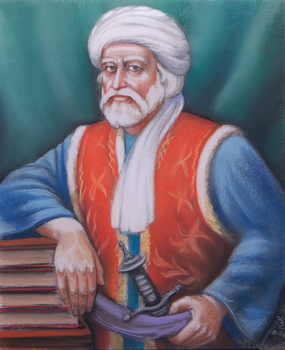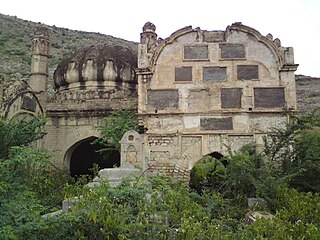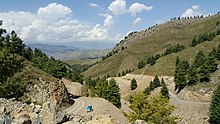
The Yusufzai or Yousafzai, also referred to as the Esapzai, or Yusufzai Afghans historically, are one of the largest tribes of Pashtuns. They are natively based in the northern part of Khyber Pakhtunkhwa, to which they migrated from Kabul during the 16th century, but they are also present in parts of Afghanistan, including Kunar, Kabul, Kandahar and Farah. Outside of these countries, they can be found in Ghoriwala District Bannu, Balochistan Sibi (Akazai), Chagai (Hassanzai) and Rohilkandh.

The Shinwari are an ethnic Pashtun tribe of Afghanistan and Pakistan. Among the greatest poets of the Pashto language in the 20th century was the late Ameer Hamza Shinwari, also known as "Hamza Baba".

Khošāl Khān Khaṭak the renowned King of Kings(Pashto: خوشال خان خټک; Urdu, Persian: خوشحال خان خٹک; 1613 – 20 February 1689), also known as Khushal Baba, was a 17th-century Pashtun poet, chief, and warrior. Khushal Khan served the Mughal Empire protecting them from Pashtun warriors over most of his lifespan. After being expelled from his tribal chiefdom and replaced with his son by his Mughal superiors, Khushal Khan turned against the Mughals. Afterwards, Khushal preached the union of all Pashtuns, and encouraged revolt against the Mughal Empire, promoting Pashtun nationalism in the last years of his life through poetry. Much of Khushal's poetry is in Pashto but some is also in Persian. Khushal is considered the "father of Pashto literature" and the national poet of Afghanistan.

The Afrīdī are a Pashtun tribe present mostly in tribal areas in Khyber Pakhtunkhwa, Pakistan.

The Bangash, Bungish, Bangaš or Bangakh are a tribe of Pashtuns, inhabiting their traditional homeland, the Bangash district which stretches from Kohat to Tall in Hangu and Spīn Ghar, Kurram in Khyber Pakhtunkhwa, Pakistan. They also live as a smaller population in Dera Ismail Khel, Bannu while also a smaller population of Bangash inhabit mainly Gardez, Paktia and around the Lōya Paktia region of Afghanistan.
The Rōshānī movement was a populist, nonsectarian Sufi movement that was founded in the mid-16th century, in the Pashtunistan region of present-day Pakistan and Afghanistan, and arose among the Pashtun tribes. The movement was founded by Pir Roshan, an Ormur warrior, Sufi poet and revolutionary. Roshan challenged the inequality and social injustice that he saw being practiced by the ruling powers of the Mughal Empire. He advocated for a system of egalitarian codes and tenets that his followers, the Roshaniyya, promulgated within Islam. Pir Roshan educated and instructed followers of the movement through new and radical teachings that questioned basic Islamic canons during that time, and propagated egalitarian principles. His teachings resonated among the Afridi, Orakzai, Khalil, Mohmand, and Bangash tribes.
Lanḍī Kōtal or Lwargai is a town in the Province of Khyber Pakhtunkhwa in Pakistan, and the administrative capital of Khyber District. It was one of the largest towns in the former Federally Administered Tribal Areas, and is located 1,072 metres (3,517 ft) above sea level, on the route across the mountains to the city of Peshawar. Landi Kotal is at the western edge of the Khyber Pass that marks the entrance to the Nangarhar Province of Afghanistan, which is located just 5 kilometres (3 mi) to the west.

The Tirah campaign, often referred to in contemporary British accounts as the Tirah expedition, was an Indian frontier campaign from September 1897 to April 1898. Tirah is a mountainous tract of country in what was formerly known as Federally Administered Tribal Areas of Pakistan, now Khyber Pakhtunkhwa province.

Orakzai District is a district in the Kohat Division of the Khyber Pakhtunkhwa province of Pakistan. Before 1973, it was part of FR Kohat. Up until 2018, it was an agency within the erstwhile Federally Administered Tribal Areas. However, with the merger of the FATA with Khyber Pakhtunkhwa, it attained the status of a district.

Khyber District is a district in the Peshawar Division of the Khyber Pakhtunkhwa province of Pakistan. Until 2018, it was an agency of the erstwhile Federally Administered Tribal Areas. With the merger of FATA with Khyber Pakhtunkhwa in 2018, it became a district. It ranges from the Tirah valley down to Peshawar. It borders Nangarhar Province to the west, Orakzai District to the south, Kurram District to southwest, Peshawar to the east and Mohmand District to the north.

Bāyazīd Khān Ansārī, commonly known as Pīr Rōshān or Pīr Rōkhān, was an Ormur warrior, Sufi poet and revolutionary leader. He wrote mostly in Pashto, but also in Persian, Urdu and Arabic. His mother tongue was Ormuri. He is known for founding the Roshani movement, which gained many followers in present-day Pakistan and Afghanistan, and produced numerous Pashto poets and writers.
The Orakzai are a Pashtun tribe native to the Orakzai Agency and parts of Kurram and Khyber Agencies in Pakistan's Khyber Pakhtunkhwa province. Additionally, a sub-tribe of the Orakzai resides in Afghanistan's Maidan Wardak Province. The Orakzai people predominantly speak Pashto.

Kohat Division is one of the seven divisions in the Khyber Pakhtunkhwa province of Pakistan. It consists of five districts: Hangu, Karak, Kohat, Kurram, and Orakzai. The division borders Bannu Division to the south and west, Peshawar Division to the north and east, the province of Punjab to the east, and Afghanistan to the northwest. CNIC code of Kohat Division is 14.
The Ghoryakhel is a Pashtun sub-tribe.

The Mullagori or Mulagori or Malagori is a Pashtun tribe present in Khyber District, tribal areas in Khyber Pakhtunkhwa, Pakistan. Historically, they are one of the smallest tribes of ethnic Pashtuns. They are considered as a sub-tribe of Momand Pashtun Ghoryakhel confederacy.
Tirahi are Indo-Aryan people who are native and original inhabitants of Tirah valley. They are closely related to their Dardic neighbours and speak Tirahi language, a nearly extinct if not already extinct Indo-Aryan language which may still be spoken by older adults, who are likewise fluent in Pashto, in a few villages in the southeast of Jalalabad in Nangarhar Province, Afghanistan. They were the previous inhabitants of Tirah and the Peshawar Valley in modern-day Khyber Pakhtunkhwa, Pakistan.

Saleh Khana is a large village in the Nowshera District of Khyber Pakhtunkhwa, Pakistan located just below the Cherat mountains.
The Chamkani, is a sub-tribe of Ghoryakhel Pashtuns. According to Muhammad Hayat Khan, author of Hayat-i-Afghani Chamkani are descendants of Ibrahim Ghoria. They are also related to Mohmand, Daudzai and Khalil through their Sarbani descent.
Maidan, or Tirah Maidan, is a remote valley located in the Tirah region in Khyber Agency, Pakistan.
The Afridi Redshirt Rebellion was a military campaign conducted by British Indian Army against Afridi tribesmen Ajab Khan Afridi in the North West Frontier region of the Indian Empire, now in Pakistan in 1930–1931.













